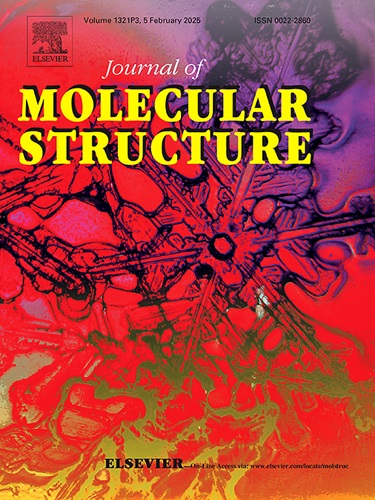Synthesis and characterization of iron oxide-thalidomide nanoconjugates for enhanced anti-inflammatory activities
IF 4
2区 化学
Q2 CHEMISTRY, PHYSICAL
引用次数: 0
Abstract
Thalidomide, recognized for its anti-inflammatory, immunomodulatory, and antiemetic characteristics, is impeded due to its teratogenic effects. This research investigates the synthesis and characterization of iron oxide-thalidomide nanoconjugates (FeOX-TH) in order to enhance its pharmacological activity. Iron oxide nanoparticles (FeOX-NPs) were synthesized via a coprecipitation method and conjugated with thalidomide, as confirmed by UV–Vis, FTIR, XRD, SEM, and EDS analyses. UV–Vis and FTIR studies demonstrated distinct absorption peaks and molecular vibrations indicative of effective conjugation. XRD and EDS analysis confirmed the structure and composition of the resultant conjugates. Assays for anti-phospholipase A2 (PLA2) activity revealed a notable enhancement in inhibitory potential, with the FT4 conjugate reaching 71 % inhibition, surpassing FT3 at 67 %, FT2 at 44 %, FT1 at 11 %, and NPs free thalidomide at 40 %. The process of nanoconjugation enhanced anti-inflammatory activity in a dose-dependent manner. The findings highlight the potential of FeOX-TH conjugates, particularly FT4, as effective agents against inflammatory and oncological disorders. The combination of nanotechnology and pharmacology offers a potential strategy to enhance thalidomide’s effectiveness, though further studies are required to evaluate its safety profile, including potential toxicity concerns.
增强抗炎活性的氧化铁-沙利度胺纳米偶联物的合成和表征
沙利度胺以其抗炎、免疫调节和止吐特性而闻名,但由于其致畸作用而受到阻碍。本文研究了氧化铁-沙利度胺纳米偶联物(FeOX-TH)的合成和表征,以提高其药理活性。采用共沉淀法合成了氧化铁纳米颗粒(FeOX-NPs),并与沙利度胺偶联,通过UV-Vis、FTIR、XRD、SEM和EDS等分析证实了这一结果。UV-Vis和FTIR研究显示明显的吸收峰和分子振动表明有效的共轭。XRD和EDS分析证实了产物的结构和组成。抗磷脂酶A2 (PLA2)活性测定显示,抑制潜力显著增强,FT4偶联物达到71%的抑制作用,超过FT3 67%, FT2 44%, FT1 11%, NPs游离沙利度胺40%。纳米偶联过程以剂量依赖的方式增强抗炎活性。这些发现强调了FeOX-TH缀合物,特别是FT4,作为对抗炎症和肿瘤疾病的有效药物的潜力。纳米技术和药理学的结合为提高沙利度胺的有效性提供了一种潜在的策略,尽管需要进一步的研究来评估它的安全性,包括潜在的毒性问题。
本文章由计算机程序翻译,如有差异,请以英文原文为准。
求助全文
约1分钟内获得全文
求助全文
来源期刊

Journal of Molecular Structure
化学-物理化学
CiteScore
7.10
自引率
15.80%
发文量
2384
审稿时长
45 days
期刊介绍:
The Journal of Molecular Structure is dedicated to the publication of full-length articles and review papers, providing important new structural information on all types of chemical species including:
• Stable and unstable molecules in all types of environments (vapour, molecular beam, liquid, solution, liquid crystal, solid state, matrix-isolated, surface-absorbed etc.)
• Chemical intermediates
• Molecules in excited states
• Biological molecules
• Polymers.
The methods used may include any combination of spectroscopic and non-spectroscopic techniques, for example:
• Infrared spectroscopy (mid, far, near)
• Raman spectroscopy and non-linear Raman methods (CARS, etc.)
• Electronic absorption spectroscopy
• Optical rotatory dispersion and circular dichroism
• Fluorescence and phosphorescence techniques
• Electron spectroscopies (PES, XPS), EXAFS, etc.
• Microwave spectroscopy
• Electron diffraction
• NMR and ESR spectroscopies
• Mössbauer spectroscopy
• X-ray crystallography
• Charge Density Analyses
• Computational Studies (supplementing experimental methods)
We encourage publications combining theoretical and experimental approaches. The structural insights gained by the studies should be correlated with the properties, activity and/ or reactivity of the molecule under investigation and the relevance of this molecule and its implications should be discussed.
 求助内容:
求助内容: 应助结果提醒方式:
应助结果提醒方式:


